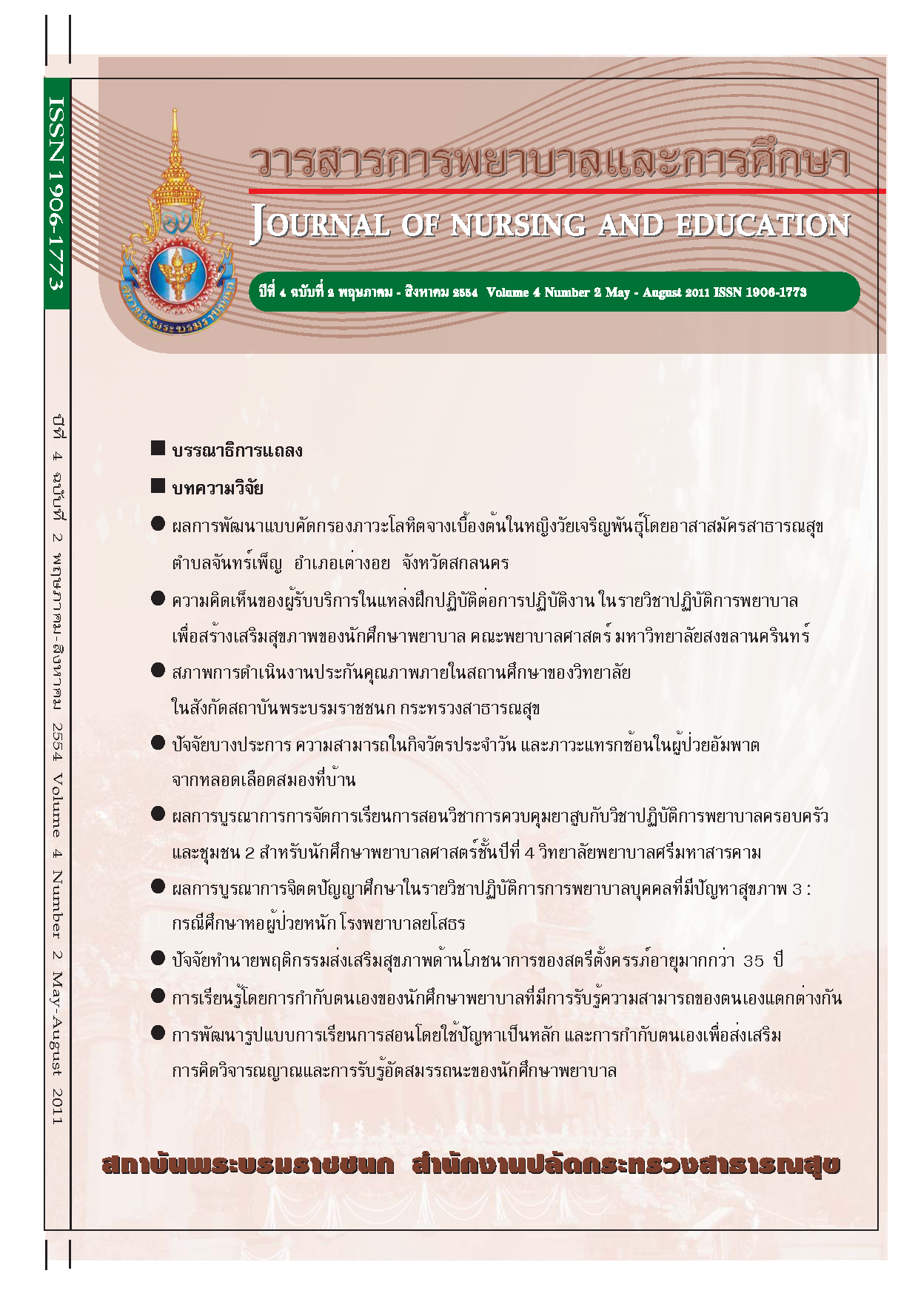ผลการพัฒนาแบบคัดกรองภาวะโลหิตจางเบื้องต้นในหญิงวัยเจริญพันธุ์โดยอาสาสมัครสาธารณสุข ตำบลจันทร์เพ็ญ อำเภอเต่างอย จังหวัดสกลนคร
คำสำคัญ:
verbal screening for anemia, Reproductive aged womenบทคัดย่อ
บทคัดย่อ
ประเทศไทยพบ อุบัติการณ์ภาวะโลหิตจางในหญิงวัยเจริญพันธุ์ทั่วประเทศ ร้อยละ 40.7 โลหิตจาง
เป็นภาวะที่มักจะไม่ปรากฏอาการให้เห็นเด่นชัด ผู้ป่วยจึงอาจมีภาวะโลหิตจางโดยไม่ปรากฏอาการอัตราการเกิด ภาวะโลหิตจาง ในสตรีวัยเจริญพันธุ์ของพื้นที่ตำบลจันทร์เพ็ญ อำเภอเต่างอย จังหวัดสกลนคร พบร้อยละ 35 ซึ่งสูงกว่า เป้าหมาย ของแผนพัฒนาสาธารณสุขฉบับที่ 10 ที่กำหนดให้อัตราการเกิดภาวะ โลหิตจางในหญิงวัยเจริญพันธุ์ไม่เกิน ร้อยละ 10
การศึกษาครั้งนี้เป็นโครงการวิจัยและพัฒนา ในระยะที่ 1 มีวัตถุประสงค์เพื่อพัฒนาและประเมินผล ความแม่นยำ ของใช้แบบคัดกรองภาวะโลหิตจางในหญิงวัยเจริญพันธุ์โดยอาสาสมัครสาธารณสุข ในพื้นที่ ตำบลจันทร์เพ็ญ ศึกษาในช่วงเดือน กุมภาพันธ์ 2552 ถึง กุมภาพันธ์ 2553 กลุ่มตัวอย่างเป็นหญิงวัยเจริญพันธุ์ทุกคน ที่อาศัยอยู่ในพื้น ที่บ้านนาหลวง จำนวน 61 ราย และหญิงวัยเจริญพันธุ์ทุกคนที่อาศัยอยู่ในพื้นที่บ้านบึงสา จำนวน 58 ราย รวม 119 ราย ดำเนินการศึกษาโดย 1) พัฒนาแบบคัดกรอง Anemia Screening Form 2) อบรมความรู้ และ
ฝึกการใช้แบบคัดกรอง ให้กับอาสาสมัครสาธารณสุข 3) อาสาสมัครสาธารณสุขคัดกรองภาวะโลหิตจาง ในหญิง วัยเจริญพันธุ์ด้วยแบบคัดกรอง Anemia Screening Form 4) ในรายที่พบผลบวก จากการใช้ Anemia Screening Form กลุ่มตัวอย่างจะถูกส่งต่อเพื่อเจาะเลือด และตรวจอุจจาระหาพยาธิ
ผลการศึกษาพบว่า
1. หญิงวัยเจริญพันธุ์จำนวน 119 คน ได้รับการคัดกรองด้วย Anemia Screening Form พบมี ความเสี่ยง ต่อการเกิดภาวะโลหิตจางที่ต้องส่งต่อ จำนวน 91 ราย คิดเป็นร้อยละ 76.4
2. หญิงวัยเจริญพันธุ์ที่มีความเสี่ยงต่อการเกิดภาวะโลหิตจาง จำนวน 91 ราย พบมี ภาวะโลหิตจาง
28 ราย คิดเป็นร้อยละ 30.7
3. ในกลุ่มที่มีภาวะโลหิตจาง 28 ราย ตรวจพบ พาหะธาลัสซีเมีย 4 ราย คิดเป็นร้อยละ 14.2 พบพาหะธาลัสซีเมีย ร่วมกับภาวะพร่อง/ขาดธาตุเหล็ก 4 ราย คิดเป็นร้อยละ 14.2 พบภาวะพร่อง/ขาดธาตุเหล็ก
12 ราย คิดเป็น ร้อยละ 42.8 และโลหิตจางไม่ทราบสาเหตุ 8 ราย คิดเป็นร้อยละ 28.5
4. โดยภาพรวมทั้ง 2 หมู่บ้านมีกลุ่มตัวอย่างที่มีภาวะโลหิตจาง 28 ราย คิดเป็นร้อยละ 23.5
5. แบบคัดกรองภาวะโลหิตจางในหญิงวัยเจริญพันธุ์ มีค่าความไว (Sensitivity) ของเครื่องมือ ร้อยละ 100 ค่าความจำเพาะ (Specificity) ของเครื่องมือร้อยละ 30.7 และประสิทธิภาพ (Efficiency) ของเครื่องมือ
ร้อยละ 47
ผลการศึกษาชี้ให้เห็นว่า การใช้แบบคัดกรองภาวะโลหิตจางแบบ Anemia Screening Form โดยอาสา สมัครสาธารณสุข เป็นเครื่องมือเบื้องต้นที่สามารถค้นหาหญิงวัยเจริญพันธุ์ที่มีความเสี่ยงต่อภาวะโลหิตจางและช่วย ให้หญิงวัยเจริญพันธุ์ได้รับ การส่งต่อเพื่อการวินิจฉัยและรักษาอย่างเหมาะสม อีกทั้งควรศึกษาผลการใช้แบบคัดกรอง ภาวะโลหิตจางในกลุ่ม หญิงวัยเจริญพันธุ์อื่นๆ เพื่อเพิ่มความจำเพาะ ความแม่นยำ และประสิทธิภาพ ของเครื่องมือ ต่อไป
Abstract
It has been found that 40.7 percents of Thai reproductive aged women were anemia.
The symptoms of anemia are not clearly shown. Therefore, the patient may not recognized anemia from sign, as most of them were anemia without any symptoms. The ratio of anemia in reproductive aged women at Chanpen Sub-distric, Taongoi District, Sakonnakorn Province is 35 percent which was higher than
the target of the 10
th
Health Development Plan (HDP) which is targeted at less than at 10 percent
This study was the first phase of the research and development project aiming to develop and assess
the use of Screening Anemia Form in Thai reproductive aged women by public health volunteers at Chanpen Sub-district, Taongoi District , Sakonnakorn Province. It was conducted from February 2009 to February 2010. The 119 samples were reproductive aged women living in Bann Na-luang (61 cases) and Baan Bung-sa. (58 cases). This study consisted of 4 stages: 1) developing Anemia Screening Form,
2) providing knowledge and training for public health volunteers to use Anemia Screening Form,
3) assessing anemic conditions by public health volunteers using Anemia Screening Form, and 4) referring anemia samples for parasite stool examination.
The results showed that
1. There were 91 (76.4 %) of 119 samples who were at risk of anemia.
2. Of those 91 samples at risk of anemia, there were 28 samples (30.7 %) with anemia.
3. Of those 28 samples with anemia, there were 4 cases of thalassemia carriers (14.2 %), 4 cases of thalassemia carriers together with iron deficiency condition (14.2 %), 12 cases of iron deficiency
condition (42.8 %), and 8 cases of unknown cause of anemia (28.5 %).
4. The total number of anemia samples from both villages was 28 cases (23.5 %).
5. The percentage of sensitivity, specificity, and efficiency of anemia Screening Form was 100, 30.7, and 47.0, respectively.
The results of this study indicated that the Anemia Screening Form could be used as a primary screening by public health volunteers to assess anemia condition for reproductive aged women who are at risk of anemia. In addition, it could be used as primary screening to indentified before referring reproductive aged women who are at risk of anemia for further appropriate treatment. The repeat of Anemia Screening Form study needs to be tested in other samples to enhance the tool sensitivity, specificity, and efficiency.






